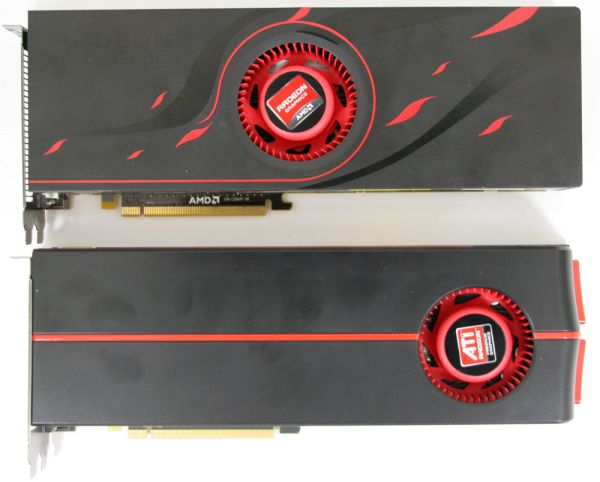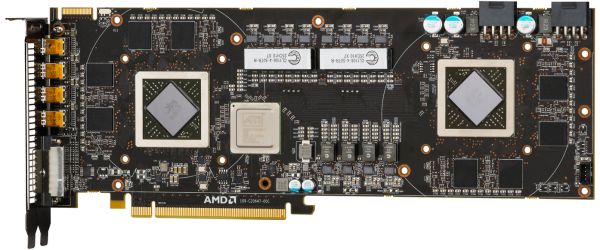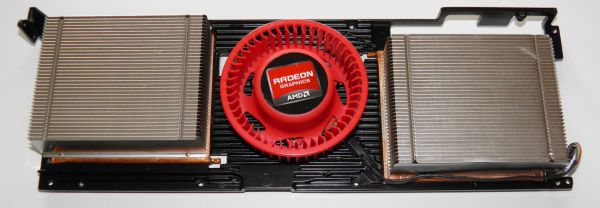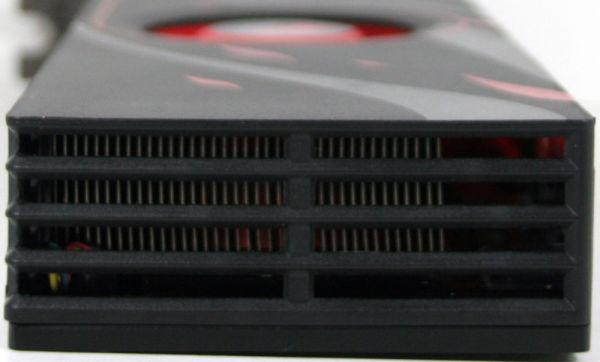AMD's Radeon HD 6990: The New Single Card King
by Ryan Smith on March 8, 2011 12:01 AM EST- Posted in
- AMD
- Radeon HD 6990
- GPUs
Meet The 6990
If you recall our coverage on the 5970, we found a few areas where AMD was lacking. The cooling on the 5970 was sufficient to run the GPUs even at 5870 clocks and voltages, however the cooling on the VRMs was lacking, leading to real world programs trigging the VRM thermal protection mechanism; and while this was within safety guidelines, it’s not a comfortable place to be for long term operation. This ultimately led to us writing off the 5970OC as a 100% reliable product, sticking to recommending the 5970 solely at stock speeds.
The design of the 6990 in turn reads very much like a response to our findings in true engineering fashion. Furthermore for the 6990 AMD not only had to take a look at the 5970’s weaknesses, but also how to handle an even greater power load. The result is that the 6990 is distinctly different from the 5970 before it.
Compared to the 5970, the 6990 is ever so slightly shorter, thanks in large part to the fact than the 6000 series casing is more squared off compared to the 5000 series’ tapered design. As a result it comes in at 11.5” for the PCB (the same as the 5970), and with casing a full 12” long compared to the 5970’s 12.16”. This means that the 6990 has effectively the same space requirements as the 5970, cooling notwithstanding.
Meanwhile it’s the fan however that is going to catch the most attention and this is where we’re going to dovetail in to cooling. The 5970’s traditional blower had its strengths and weaknesses, the strengths being that blowers are relatively forgiving about a case’s ability to exhaust hot air, and the weaknesses being that the GPU (and VRMs) closest to the fan received better cooling than the farther GPU. The VRMs proved to be particularly problematic, as they could overheat well before the GPUs did and AMD does not spin up their fans based on VRM temperatures.
Correcting for this and at the same time allowing for even greater heat dissipation, the rear blower design is out. Its replacement is a design that we’ve seen in 3rd party cards before such as the Asus ARES 5870X2, but not in a reference design: a center-mounted fan/blower with a GPU to each side. The difference is critical and indeed cannot be understated: a rear blower channels most hot air outside of the case, while a center-mounted blower effectively splits the card in two, with one GPU + supporting chips being exhausted outside of the case, and the 2nd GPU + supporting chips being exhausted inside the case. The design is still enclosed, so everything goes out either the front or back of the card while fresh air is pulled in the center.
With the replacement of the blower, so has gone the heatsink. The 5970’s single large vapor chamber + heatsink design has been replaced in favor of a segmented heatsink, further driving home the concept that the 6990 is closer to 2 video cards sharing 1PCB than it is 2 GPUs on one card. Each heatsink in turn is connected to the GPU via its own vapor chamber, resulting in the GPUs being fully isolated from each other as far as cooling is concerned.
Even the thermal paste connecting the GPUs to the vapor chambers has been changed for the 6990 – AMD has replaced traditional paste with a phase change material. Phase change materials – pastes/pads of material that melt and solidify based on temperature are nothing new, however they’re still exotic; material similar to what AMD is using is not readily available as paste is. AMD even went so far as to suggest that reviewers not directly disassemble their 6990s as it would require a new application of phase change paste in order to achieve the same efficiency as the original material. The net result of all of this by AMD’s numbers is that the phase change material is 8% better than the regular paste they’ve been using.
Rounding out our focus on cooling is the VRMs, which have been relocated in order to correct for the 5970’s limited VRM cooling capabilities. The VRMs and controllers are now at the center of the board – now they’re cooled before the GPUs or RAM modules are. The profoundness of this is twofold: not only is it an improvement on the 5970, but with the 6990’s higher power consumption VRM cooling is even more important. As with the 6970, voltage regulation is supplied by Volterra MOSFETs and controllers.
All told, while the 5970 was designed to handle and dissipate 400W of heat, the 6990 is officially designed for 450W. In practice, at its limits in our test rig this is closer to 500W. To handle and dissipate that much heat in roughly 72in3 of space is nothing short of amazing.


















130 Comments
View All Comments
Figaro56 - Tuesday, March 8, 2011 - link
2 HD 6970 Cards for $640? I don't think so! These cards are over $300 everywhere. I purchased 2 for $710 shipped and I thought that was a deal. Maybe reviews like yours here inflated the price and I purchased after the price adjustment. I have the same luck with gasoline on days I fill my tank.ViRGE - Tuesday, March 8, 2011 - link
Looking at the Egg, there's 2 different 6970s at $320, which is probably where AT got $640 from.http://www.newegg.com/Product/Product.aspx?Item=N8...
Figaro56 - Tuesday, March 8, 2011 - link
All right, you got me there. I only buy XFX double lifetime warranty cards when I start spending this much on replacing my dual GPU solution.I seem to manage to actually re-sell my used video cards when I can offer then to a buyer with a lifetime warranty. XFX double lifetime warranty is not a sales gimic, it works. Heck, I would buy a used card if it had a lifetime warranty, it's kind of a no brainer given you actually want to buy that card int he first place.
Arbie - Tuesday, March 8, 2011 - link
Thanks for keeping the Crysis Warhead minimum FPS charts!! To me, Crysis/Warhead remains the defining game (and not only technically). I don't even look at the numbers on the other titles.Also of prime importance to me are the idle power and, to a slightly lesser extent, idle noise.
Of course, like most people reading your review, I wouldn't be buying a 6990 even if it were silent. In fact, given that PC graphics requirements are apparently ramping down to console levels, I wonder how AMD/Nvidia are going to sell any significant number of cards above midrange. My HD 5770 will run everything at 1920x1200, though not always with all sliders maxed. However, I don't see much if any difference (in DX9) when I do enable 4xAA vs 2xAA etc. Certainly not enough to double the price of this $140 card.
A nit on the Crysis Warhead minimum fps chart for 1920x1200 Frost Bench - Gamer Quality - Enthusiast Shaders + 4xAA: Your Dec 10 chart shows 6970CF at 66.2 fps but this Mar 11 chart shows 66.6. Can you believe anyone would actually notice this, much less comment on it? We are too absorbed in this tech stuff (ain't it grand...).
strikeback03 - Tuesday, March 8, 2011 - link
They did say the new drivers made a slight difference, that seems likely to be one of the configurations they retestedmorphologia - Tuesday, March 8, 2011 - link
That isn't portrait orientation in the picture...it's landscape.taltamir - Tuesday, March 8, 2011 - link
The card was measured at 77.3db in the article.1. At what distance was it measured?
2. What is its db measurement 1 meter away?
taltamir - Tuesday, March 8, 2011 - link
I just looked it up, gold is worth 1430$/ounce right now.I highly doubt a watercooled 6990 will weigh half an ounce.
ekrash - Tuesday, March 8, 2011 - link
The performance bottleneck is also seen in nvidia's dual gpu offerings. Dual GPU cards operating in X16 PCIe slots must have their data lanes divided between the gpu's, so they are effectively operating at X8 data rates, not at X16 data rates. Whereas single gpu cards will utilize all X16 express lanes, and even then the PCIexpress standard may soon be obsoleted. I hope we can look forward to Intel's fiber optic technology effectively replacing all data bus signalling with 10GB fiber optic bus and peripheral device signalling which can simultaneously and independently utilize all of the different data protocols used for inter-device and system bus communications. Imagine soon AMD and Nvidia will be producing video cards with fiber-optic data buses which may change requirements for power supplied to present day PCI express slots and may change the standards in power supply manufacturing to require that additional power connector to a video card since the 75 watt PCIe slot will be obsolete.But ATI and Nvidia may also have to work with motherboard manufacturers to see if Intel's "Thunderbolt" fiber optic data buses can increase or freely throttle the video data bandwidth through its 10GB interface and would be tantamount to increasing data lanes from X16 to X32. It would be almost unlimited video bandwidth which far exceeds any bandwidth limitations vs availability that is needed today. Dual GPU's cannot promise the performance with the limitation of the PCIe X16 slot being divided to dual X8 channels, but it would be nice to see how they perform with unlimited bandwidth potential over a single 10GB fiber-optic. And that would change the battlefield between ATI-AMD and Nvidia.
My 4870 X2's (Can run Quadfire) still rocks on enthusiast settings in Crysis and Warhead without any hiccups and I've not seen a slowdown of any sort on any level in Crysis.
The price to performance ratio is declining and may affect my decision to purchase another dual GPU card, opting instead for single GPU card CF solutions that can utilize all X16 lanes by the GPU.
BTW I did notice the lack of DATA on Crysis @1920x1200 with full enthusiast settings, so that data is missing from this review. Its Gamer plus enthusiast shaders.....not full enthusiast. As above the 4870 X2 runs full enthusiast settings, not one setting is scaled back, and not one hiccup....just smooth play throughout on a single 28" display.
cmdrdredd - Tuesday, March 8, 2011 - link
Why are we still using Crysis Warhead at "Gamer Quality"????? With cards like these why not turn everything maxed in game and then fidget with AA and the like? I don't get it.